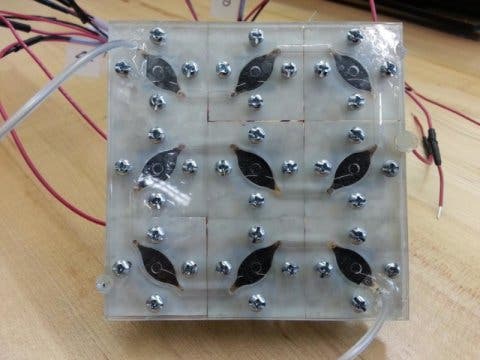On the desk of Seokheun “Sean” Choi sits a 3×3 array that at first glance looks like a lemon squeezer. It is, in fact, a solar panel but not like any you’ve seen or heard about before. Instead of using semiconductors like silicon crystals to convert sunlight into electricity, the array employs a complex system that nurtures cyanobacteria — beings whose metabolism create free electrons which can be harnessed.
Choi and colleagues at Binghamton University have been working on the bacteria solar cell for years now. Last year they significantly improved their design by changing the materials for the anodes and cathodes. They also used a microfluidic system chamber that houses and feeds the bacteria, instead of a dual-chamber reactor. Now, they’ve shown how to stack each cell into an array, proving the design is scalable.
Cyanobacteria, being photosynthetic organisms, use the sun’s energy, H2O and CO2 to synthesize their energy storage components, i.e. carbohydrates, lipids and proteins. Some researchers have proposed that it may be feasible to use cyanobacteria to make biofuels and even hydrogen fuel by the reversible activity of hydrogenase. The Binghamton University researchers, however, are tapping directly into the photocurrent generated by the bacteria themselves.
“Once a functional bio-solar panel becomes available, it could become a permanent power source for supplying long-term power for small, wireless telemetry systems as well as wireless sensors used at remote sites where frequent battery replacement is impractical,” said Choi, an assistant professor of electrical and computer engineering in Binghamton University’s Thomas J. Watson School of Engineering and Applied Science, and co-author of the paper.
“This research could also enable crucial understanding of the photosynthetic extracellular electron transfer processes in a smaller group of microorganisms with excellent control over the microenvironment, thereby enabling a versatile platform for fundamental bio-solar cell studies,” said Choi.
I know you like numbers, so let’s look at some figures. A typical solar panel configuration of, say, 6×10 cells generates roughly 200 watts of electrical power. The same number of bacterial solar cells generates 0.00003726 watts, researchers report in the journal Sensors and Actuators B: Chemical. Alright, that was disappointing but this is still 1) experimental research and 2) bacterial solar cells aren’t meant to compete with traditional solar cells. It’s also worth noting that the power output was measured at 1.28 V operating voltage under a 200 kΩ external resistor, so there’s room for plenty of juice to power small devices.
The findings open the door for more research into how cyanobacteria could be used to power remote devices, like wireless sensors. Other than that, it’s pretty amazing to see other creatures besides hamsters turning a wheel generate raw electricity — and the cyanobacteria don’t seem to mind at all.
“It is time for breakthroughs that can maximize power-generating capabilities/energy efficiency/sustainability,” Choi said. “The metabolic pathways of cyanobacteria or algae are only partially understood, and their significantly low power density and low energy efficiency make them unsuitable for practical applications. There is a need for additional basic research to clarify bacterial metabolism and energy production potential for bio-solar applications.”










